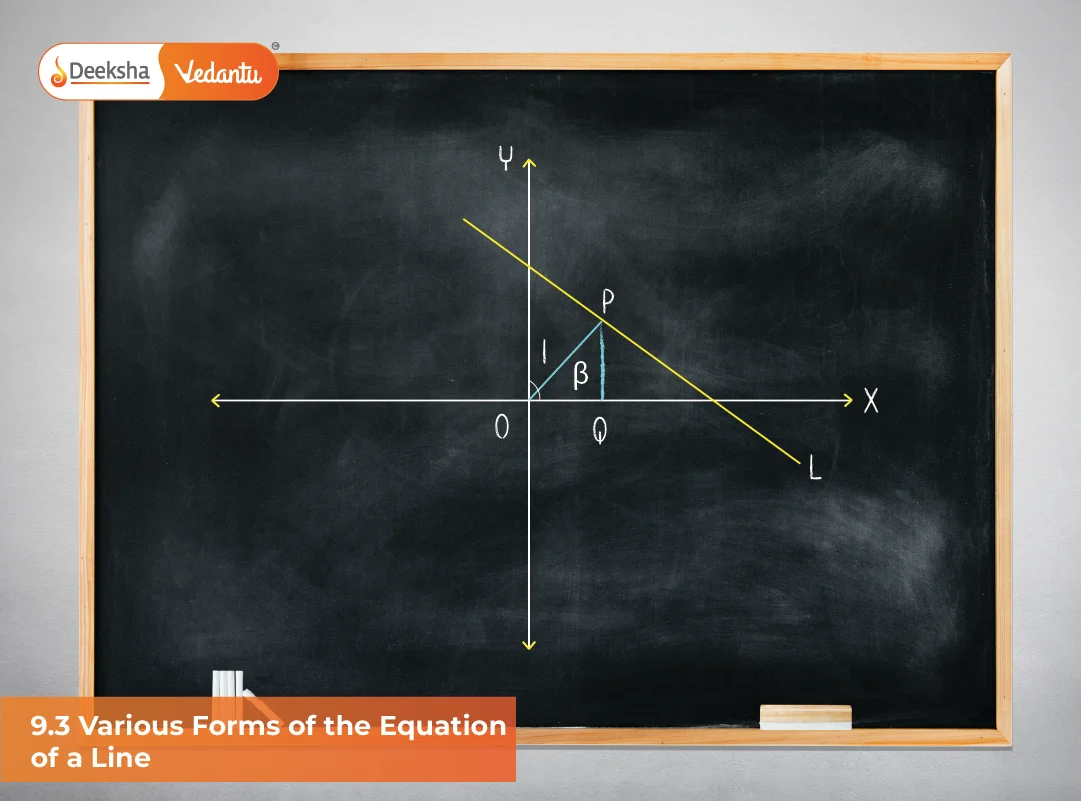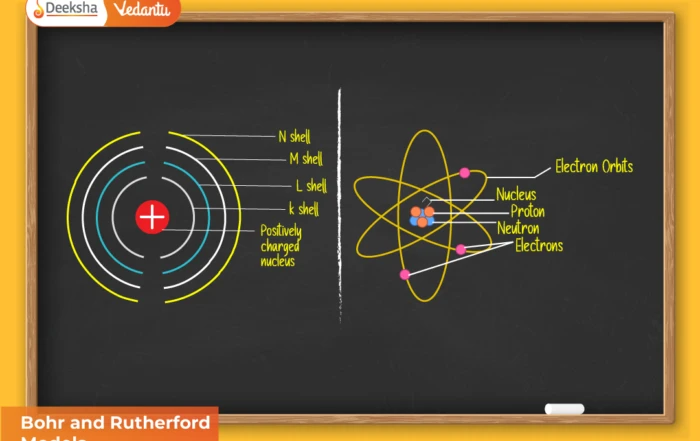
Introduction
A straight line in a plane can be represented algebraically by an equation. The beauty of coordinate geometry is that every straight line corresponds to a linear equation in x and y, and every linear equation in x and y represents a straight line.
Depending on the information given about the line (such as slope, intercepts, a point, or normal distance), different forms of equations are used. For solving problems in Boards, JEE, KCET, and COMEDK, recognizing which form is most efficient is crucial.
The standard forms of a line include:
- Slope–Intercept Form
- Point–Slope Form
- Two–Point Form
- Intercept Form
- Normal Form
- General Form
Let us study each in detail with examples and derivations.
1. Slope–Intercept Form
Equation: y = mx + c
Here,
- m = slope of the line
- c = y-intercept, i.e., point where line cuts the y-axis
Derivation
If a line cuts the y-axis at (0, c) and has slope m, then equation is:
y – c = m(x – 0) → y = mx + c
Example 1
Find equation of line with slope 3 and y-intercept –2.
Equation: y = 3x – 2.
Example 2
Find y-intercept of line y = –4x + 7.
Comparing y = mx + c → slope m = –4, y-intercept c = 7.
2. Point–Slope Form
Equation: y – y₁ = m(x – x₁)
Here, line passes through point (x₁, y₁) with slope m.
Derivation
Using slope formula: slope m = (y – y₁)/(x – x₁). Rearranging → y – y₁ = m(x – x₁).
Example 3
Find equation of line with slope 2 passing through (1, –3).
Equation: y + 3 = 2(x – 1) → y = 2x – 5.
3. Two–Point Form
Equation: (y – y₁)/(y₂ – y₁) = (x – x₁)/(x₂ – x₁)
Here, line passes through two known points (x₁, y₁) and (x₂, y₂).
Derivation
Slope of line = (y₂ – y₁)/(x₂ – x₁). Substituting slope in point-slope form → formula above.
Example 4
Find the equation of line through (–2, 3) and (4, 7).
Equation: (y – 3)/(7 – 3) = (x + 2)/(4 + 2) → (y – 3)/4 = (x + 2)/6.
4. Intercept Form
Equation: (x/a) + (y/b) = 1
Here,
- a = x-intercept (point where line cuts x-axis)
- b = y-intercept (point where line cuts y-axis)
Derivation
If line cuts x-axis at (a, 0) and y-axis at (0, b), then slope of line = (b – 0)/(0 – a) = –b/a.
Equation using point–slope form → x/a + y/b = 1.
Example 5
Find equation of line with intercepts 6 on x-axis and 4 on y-axis.
Equation: x/6 + y/4 = 1.
5. Normal Form
Equation: x cos α + y sin α = p
Here,
- p = perpendicular distance from origin to the line
- α = angle of perpendicular from origin with x-axis
Derivation
Take a line at distance p from origin. Drop a perpendicular from origin, making angle α with x-axis. Equation becomes x cos α + y sin α = p.
Example 6
Find equation of line at distance 5 units from origin making angle 60° with x-axis.
Equation: x cos 60° + y sin 60° = 5 → (x/2) + (√3y/2) = 5.
6. General Form
Equation: ax + by + c = 0
Every line can be reduced to this form, where a, b, c are real constants.
- If b ≠ 0, slope m = –a/b
- If a = 0, line parallel to x-axis
- If b = 0, line parallel to y-axis
Example 7
Equation of line with slope –2 and y-intercept 4:
y = –2x + 4 → rearranged as 2x + y – 4 = 0.
Relationship Between Different Forms
- Slope–Intercept and General: Rearrange y = mx + c into ax + by + c = 0.
- Point–Slope and Two–Point: If slope = (y₂ – y₁)/(x₂ – x₁), substituting in point–slope gives two-point form.
- Intercept form is a special case when intercepts are known.
- Normal form is helpful when perpendicular distance from origin is given.
Distance of a Point from a Line
If line is ax + by + c = 0 and point is (x₁, y₁), then:
Distance d = |ax₁ + by₁ + c| / √(a² + b²)
This formula is often combined with line forms in competitive exams.
Example 8
Find distance of (3, 4) from line 3x – 4y + 5 = 0.
d = |3(3) – 4(4) + 5|/√(3² + (–4)²) = |9 – 16 + 5|/5 = 2/5.
Family of Lines
Equation of line passing through intersection of two lines L₁ = 0 and L₂ = 0:
L₁ + λL₂ = 0, where λ is parameter.
This concept often appears in JEE Advanced and is closely linked with the general forms.
Advanced Solved Examples
Example 9: Find equation of line through (1, 2) and parallel to line 2x – 3y + 5 = 0.
Slope of given line = –a/b = –2/(–3) = 2/3.
Equation: y – 2 = (2/3)(x – 1) → 2x – 3y + 4 = 0.
Example 10: Find equation of line through intersection of x + y – 1 = 0 and 2x – 3y + 5 = 0, parallel to x + 2y – 4 = 0.
Equation through intersection: (x + y – 1) + λ(2x – 3y + 5) = 0.
Slope of required line = –1/2.
Solve for λ to get the required equation.
Example 11 (Board type): Find equation of line with intercept 4 on x-axis and parallel to y-axis.
Since the line is parallel to the y-axis, slope undefined, equation is simply x = 4.
Marks Allotment in Exams
Boards: 8–10 marks combined from line equations.
JEE Main: 1–2 questions, mostly checking quick recognition of form.
KCET/COMEDK: 2–3 questions involving intercepts and slope conditions.
JEE Advanced: 1 question involving intersection of families of lines or distance condition.
Practice Problems
- Find equation of line with slope 4 and y-intercept 5.
- Find the equation of line passing through (–2, 3) and slope –3.
- Write an equation of line through (1, –1) and (3, 5).
- Find equation of line with x-intercept 2 and y-intercept 3.
- Find equation of line at distance 4 from origin making angle 45° with x-axis.
- Write an equation of line through (3, 4) parallel to x-axis.
- Write an equation of line through (5, –2) perpendicular to y-axis.
- Find an equation of line through the intersection of 3x – y – 2 = 0 and 2x + y – 3 = 0.
- Write an equation of line through (–1, 2) and parallel to line 2x + 3y – 5 = 0.
- Find slope and intercepts of line 5x – 2y + 8 = 0.
FAQs
Q1. What is the most common equation of line used in exams?
y = mx + c (slope–intercept form).
Q2. Which form is best when two points are known?
Two–point form.
Q3. Which form is useful when perpendicular distance from origin is given?
Normal form.
Q4. How to check if a line is parallel to x-axis?
If slope = 0 or equation is y = constant.
Q5. How to check if a line is parallel to the y-axis?
If slope undefined or equation is x = constant.











Get Social